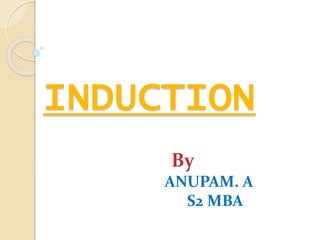
Induction
- 2. Contents Meaning Definition Objectives Purpose Steps in Induction Programme Who & How do the Induction Types of Induction Problems of Induction How to conduct Induction successfully Conclusion Reference
- 3. MEANING Induction(Orientation) is a process through which a new employee is introduced to the job and the organization. It is a technique by which a new employee is rehabilitated into his surroundings and introduced to the practices, policies and the purposes of the organization.
- 4. DEFINITION Armstrong- “ Induction is the process of receiving and welcoming an employee when he first joins a company and giving him the basic information he needs to settle down quickly and start work. “ Edwin B. Flippo-“Induction is the welcoming process to make the new employee feel at home and generate in him a feeling of belongingness to the organization.”
- 5. OBJECTIVES Remove fears Improve staff morale, work standards & revenue-profits Assist in understanding the culture & values Acts as a valuable source of information Develop a realistic job expectation, positive attitude & job satisfaction Create favorable impression of the firm & its works
- 6. PURPOSE Accommodating employees Becoming Insider Overcoming employee anxiety Overcoming reality shock Reducing employee turnover
- 7. STEPS IN INDUCTION PROCESS Welcome to the organization Explain about the company Show the department/location where the new recruit will work Give company’s manual to new recruit Give details about pay scales Explain about future training opportunities & career prospectus Clarify doubts by encouraging the employee to come out with questions
- 8. WHO & HOW DO THE INDUCTION HR department is responsible to execute the induction programme HR manager or an HR representative conducts this programme Management trainees or graduate engineer trainees are exposed to this Each industry/sector develops its own procedure as per its needs
- 10. FORMAL Vs. INFORMAL INDUCTION Formal Induction It has a structured programme. Formal programme helps a new hire in acquiring a known set of standards Informal Induction In this, employees are directly put on job. Informal programme promotes innovative ideas. Choice depends on management’s goals.
- 11. INDIVIDUAL Vs. COLLECTIVE INDUCTION Individual Induction It preserves individual differences. expensive and time consuming. smaller firms go for individual programmes. Collective Induction It is likely to develop homogenous views. less time consuming. Large firms normally have collective orientation.
- 12. SERIAL Vs. DISJUNCTIVE INDUCTION Serial induction An experienced employee inducts a new hire in case of serial Induction. maintains traditions and customs. Disjunctive Induction new hire do not have predecessors to guide them. produces more inventive employees.
- 13. INVESTITURE Vs DIVESTITURE INDUCTION Investiture Induction It seeks to ratify the usefulness of the features that the person brings to new job. Follows high level appointments. Divestiture Induction It seeks to make minor modifications in the features of new employee.
- 14. PROBLEMS OF INDUCTION 1. Busy or Untrained supervisor 2. Too much information 3. Overloaded with paperwork 4. Given menial tasks 5. Employee thrown into action soon 6. Wrong perceptions of employees
- 15. TOPICS COVERED IN INDUCTION PROCESS Introduction Organizational issues Job duties Employee benefits
- 16. INTRODUCTION To supervisors To co-workers To trainers To employee councilors
- 17. ORGANIZATIONAL ISSUES History of the company Names and titles of key executives Probationary period Products/services offered Overview of the company’s procedures Disciplinary procedure
- 18. JOB DUTIES Job locations Job tasks Job safety needs Overview of jobs Job objectives Relationship with other jobs
- 19. EMPLOYEE BENEFITS Pay scales Vacations, holidays Training avenues Insurance, medical, and retirement benefits
- 20. HOW TO CONDUCT INDUCTION SUCCESSFULLY A systematic plan should be followed. A check list of points to be included in induction should be prepared. An induction booklet should be provided. Anyone who is promoted or transferred from one job to another should also be inducted. The aim should be to convey a clear picture of the working of the organisation.
- 21. CONCLUSION In my words, Induction yea Orientation play important role in success of an organisation by acquainting a new employee to the new environment, rules and regulations which in turn helps in better performance.
- 22. REFERENCE Human Resources Management- Aswathappa Personnel Management- G.B. Mamoria & S.V.Gankar Human Resources Management-VSP Rao
